Machine Learning in Automated Monitoring of Metabolic Changes Accompanying the Differentiation of Adipose-Tissue-Derived Human Mesenchymal Stem Cells Employing 1H-1H TOCSY NMR
Abstract
:1. Introduction
2. Materials and Methods
2.1. Machine Learning and Novelty Detection
2.2. Sample Preparation and Experimentation
2.2.1. Cultivation of AT-Derived hMSCs
2.2.2. Adipogenic and Osteogenic Differentiation of AT-Derived hMSCs
2.2.3. Intracellular Metabolites Extraction
2.3. High Resolution 1D and 2D NMR Experiments
2.4. Metabolic Profiling Assignment
3. Datasets
4. Results and Discussion of the Metabolic Evolution of AT-Derived hMSCs
5. Conclusions
Author Contributions
Funding
Institutional Review Board Statement
Informed Consent Statement
Data Availability Statement
Conflicts of Interest
References
- Saeedi, P.; Halabian, R.; Fooladi, A.A.I. A revealing review of mesenchymal stem cells therapy, clinical perspectives and Modification strategies. Stem Cell Investig. 2019, 6, 34. [Google Scholar] [CrossRef]
- Andrzejewska, A.; Lukomska, B.; Janowski, M. Concise review: Mesenchymal stem cells: From roots to boost. Stem Cells 2019, 37, 855–864. [Google Scholar] [CrossRef] [Green Version]
- Alhattab, D.; Jamali, F.; Ali, D.; Hammad, H.; Adwan, S.; Rahmeh, R.; Samarah, O.; Salah, B.; Hamdan, M.; Awidi, A. An insight into the whole transcriptome profile of four tissue-specific human mesenchymal stem cells. Regen. Med. 2019, 14, 841–865. [Google Scholar] [CrossRef]
- Chu, D.-T.; Nguyen Thi Phuong, T.; Tien, N.L.B.; Tran, D.K.; Minh, L.B.; Van Thanh, V.; Gia Anh, P.; Pham, V.H.; Thi Nga, V. Adipose Tissue Stem Cells for Therapy: An Update on the Progress of Isolation, Culture, Storage, and Clinical Application. J. Clin. Med. 2019, 8, 917. [Google Scholar] [CrossRef] [Green Version]
- Funes, J.M.; Quintero, M.; Henderson, S.; Martinez, D.; Qureshi, U.; Westwood, C.; Clements, M.O.; Bourboulia, D.; Pedley, R.B.; Moncada, S.; et al. Transformation of human mesenchymal stem cells increases their dependency on oxidative phosphorylation for energy production. Proc. Natl. Acad. Sci. USA 2007, 104, 6223–6228. [Google Scholar] [CrossRef] [Green Version]
- Rocha, B.; Calamia, V.; Mateos, J.; Fernández-Puente, P.; Blanco, F.J.; Ruiz-Romero, C. Metabolic Labeling of Human Bone Marrow Mesenchymal Stem Cells for the Quantitative Analysis of their Chondrogenic Differentiation. J. Proteome Res. 2012, 11, 5350–5361. [Google Scholar] [CrossRef]
- Bispo, D.S.C.; Jesus, C.S.H.; Correia, M.; Ferreira, F.; Bonifazio, G.; Goodfellow, B.J.; Oliveira, M.B.; Mano, J.F.; Gil, A.M. NMR Metabolomics Assessment of Osteogenic Differentiation of Adipose-Tissue-Derived Mesenchymal Stem Cells. J. Proteome Res. 2022, 21, 654–670. [Google Scholar] [CrossRef]
- Salazar-Noratto, G.E.; Luo, G.; Denoeud, C.; Padrona, M.; Moya, A.; Bensidhoum, M.; Bizios, R.; Potier, E.; Logeart-Avramoglou, D.; Petite, H. Understanding and leveraging cell metabolism to enhance mesenchymal stem cell transplantation survival in tissue engineering and regenerative medicine applications. Stem Cells 2019, 38, 22–33. [Google Scholar] [CrossRef] [Green Version]
- Zhu, H.; Sun, A.; Zou, Y.; Ge, J. Inducible Metabolic Adaptation Promotes Mesenchymal Stem Cell Therapy for Ischemia. Arter. Thromb. Vasc. Biol. 2014, 34, 870–876. [Google Scholar] [CrossRef] [Green Version]
- Emwas, A.-H.; Roy, R.; McKay, R.T.; Tenori, L.; Saccenti, E.; Gowda, G.A.N.; Raftery, D.; Alahmari, F.; Jaremko, L.; Jaremko, M.; et al. NMR Spectroscopy for Metabolomics Research. Metabolites 2019, 9, 123. [Google Scholar] [CrossRef] [Green Version]
- Wishart, D.S.; Jewison, T.; Guo, A.C.; Wilson, M.; Knox, C.; Liu, Y.; Djoumbou, Y.; Mandal, R.; Aziat, F.; Dong, E.; et al. HMDB 3.0—The Human Metabolome Database in 2013. Nucleic Acids Res. 2013, 41, D801–D807. [Google Scholar] [CrossRef]
- Xu, Z.-F.; Pan, A.-Z.; Yong, F.; Shen, C.-Y.; Chen, Y.-W.; Wu, R.-H. Human umbilical mesenchymal stem cell and its adipogenic differentiation: Profiling by nuclear magnetic resonance spectroscopy. World J. Stem Cells 2012, 4, 21–27. [Google Scholar] [CrossRef]
- Gowda, G.A.N.; Zhang, S.; Gu, H.; Asiago, V.; Shanaiah, N.; Raftery, D. Metabolomics-based methods for early disease diagnostics. Expert Rev. Mol. Diagn. 2008, 8, 617–633. [Google Scholar] [CrossRef] [Green Version]
- Bingol, K.; Zhang, F.; Bruschweiler-Li, L.; Brüschweiler, R. Quantitative Analysis of Metabolic Mixtures by Two-Dimensional 13C Constant-Time TOCSY NMR Spectroscopy. Anal. Chem. 2013, 85, 6414–6420. [Google Scholar] [CrossRef] [Green Version]
- Hao, J.; Liebeke, M.; Astle, W.; De Iorio, M.; Bundy, J.G.; Ebbels, T. Bayesian deconvolution and quantification of metabolites in complex 1D NMR spectra using BATMAN. Nat. Protoc. 2014, 9, 1416–1427. [Google Scholar] [CrossRef]
- Dona, A.C.; Kyriakides, M.; Scott, F.; Shephard, E.A.; Varshavi, D.; Veselkov, K.; Everett, J.R. A guide to the identification of metabolites in NMR-based metabonomics/metabolomics experiments. Comput. Struct. Biotechnol. J. 2016, 14, 135–153. [Google Scholar] [CrossRef] [Green Version]
- Güntert, P. Automated structure determination from NMR spectra. Eur. Biophys. J. 2008, 38, 129–143. [Google Scholar] [CrossRef]
- Ross, A.; Schlotterbeck, G.; Dieterle, F.; Senn, H. Chapter 3—NMR Spectroscopy Techniques for Application to Metabonomics. In The Handbook of Metabonomics and Metabolomics; Lindon, J., Nicholson, J., Holmes, E., Eds.; Elsevier Science B.V.: Amsterdam, The Netherlands, 2007; pp. 55–112. [Google Scholar]
- Roberts, L.D.; Souza, A.L.; Gerszten, R.E.; Clish, C.B. Targeted Metabolomics. Curr. Protoc. Mol. Biol. 2012, 98, 30.2.1–30.2.24. [Google Scholar] [CrossRef]
- Ai, Z.; Zhang, Y.; Li, X.; Sun, W.; Liu, Y. Widely Targeted Metabolomics Analysis to Reveal Transformation Mechanism of Cistanche Deserticola Active Compounds During Steaming and Drying Processes. Front. Nutr. 2021, 8, 743. [Google Scholar] [CrossRef]
- Bingol, K.; Li, D.-W.; Zhang, B.; Brüschweiler, R. Comprehensive Metabolite Identification Strategy Using Multiple Two-Dimensional NMR Spectra of a Complex Mixture Implemented in the COLMARm Web Server. Anal. Chem. 2016, 88, 12411–12418. [Google Scholar] [CrossRef] [Green Version]
- Ulrich, E.L.; Akutsu, H.; Doreleijers, J.F.; Harano, Y.; Ioannidis, Y.E.; Lin, J.; Livny, M.; Mading, S.; Maziuk, D.; Miller, Z.; et al. BioMagResBank. Nucleic Acids Res. 2007, 36, D402–D408. [Google Scholar] [CrossRef] [PubMed] [Green Version]
- Cheng, Y.; Gao, X.; Liang, F. Bayesian Peak Picking for NMR Spectra. Genom. Proteom. Bioinform. 2014, 12, 39–47. [Google Scholar] [CrossRef] [PubMed] [Green Version]
- Klukowski, P.; Walczak, M.J.; Gonczarek, A.; Boudet, J.; Wider, G. Computer vision-based automated peak picking applied to protein NMR spectra. Bioinformatics 2015, 31, 2981–2988. [Google Scholar] [CrossRef] [PubMed] [Green Version]
- Chen, D.; Wang, Z.; Guo, D.; Orekhov, V.; Qu, X. Review and Prospect: Deep Learning in Nuclear Magnetic Resonance Spectroscopy. Chem. A Eur. J. 2020, 26, 10391–10401. [Google Scholar] [CrossRef] [PubMed] [Green Version]
- Abadi, M.; Agarwal, A.; Barham, P.; Brevdo, E.; Chen, Z.; Citro, C.; Corrado, G.S.; Davis, A.; Dean, J.; Devin, M.; et al. Tensorflow: Large-scale machine learning on heterogeneous distributed systems. In 12th USENIX Symposium on Operating Systems Design and Implementation (OSDI 16); USENIX Association: Savannah, GA, USA, 2016; Available online: https://www.usenix.org/conference/osdi16/technical-sessions/presentation/abadi (accessed on 30 December 2022).
- Hansen, D.F. Using Deep Neural Networks to Reconstruct Non-uniformly Sampled NMR Spectra. J. Biomol. NMR 2019, 73, 577–585. [Google Scholar] [CrossRef] [PubMed] [Green Version]
- Kwon, Y.; Lee, D.; Choi, Y.-S.; Kang, M.; Kang, S. Neural Message Passing for NMR Chemical Shift Prediction. J. Chem. Inf. Model. 2020, 60, 2024–2030. [Google Scholar] [CrossRef]
- Lee, H.H.; Kim, H. Intact metabolite spectrum mining by deep learning in proton magnetic resonance spectroscopy of the brain. Magn. Reson. Med. 2019, 82, 33–48. [Google Scholar] [CrossRef]
- Zhang, C.; Idelbayev, Y.; Roberts, N.; Tao, Y.; Nannapaneni, Y.; Duggan, B.M.; Min, J.; Lin, E.C.; Gerwick, E.C.; Cottrell, G.W.; et al. Small Molecule Accurate Recognition Technology (SMART) to Enhance Natural Products Research. Sci. Rep. 2017, 7, 14243. [Google Scholar] [CrossRef] [Green Version]
- Reher, R.; Kim, H.W.; Zhang, C.; Mao, H.H.; Wang, M.; Nothias, L.-F.; Caraballo-Rodriguez, A.M.; Glukhov, E.; Teke, B.; Leao, T.; et al. A Convolutional Neural Network-Based Approach for the Rapid Annotation of Molecularly Diverse Natural Products. J. Am. Chem. Soc. 2020, 142, 4114–4120. [Google Scholar] [CrossRef]
- Chopra, S.; Hadsell, R.; LeCun, Y. Learning a similarity metric discriminatively, with application to face verification. In Proceedings of the 2005 IEEE Computer Society Conference on Computer Vision and Pattern Recognition (CVPR’05), San Diego, CA, USA, 20–25 June 2005. [Google Scholar]
- Klukowski, P.; Augoff, M.; Zięba, M.; Drwal, M.; Gonczarek, A.; Walczak, M.J. NMRNet: A deep learning approach to automated peak picking of protein NMR spectra. Bioinformatics 2018, 34, 2590–2597. [Google Scholar] [CrossRef] [Green Version]
- Jang, M.-Y.; Chun, S.-I.; Mun, C.-W.; Hong, K.S.; Shin, J.-W. Evaluation of Metabolomic Changes as a Biomarker of Chondrogenic Differentiation in 3D-cultured Human Mesenchymal Stem Cells Using Proton (1H) Nuclear Magnetic Resonance Spectroscopy. PLoS ONE 2013, 8, e78325. [Google Scholar] [CrossRef] [Green Version]
- Bispo, D.S.C.; Michálková, L.; Correia, M.; Jesus, C.S.H.; Duarte, I.F.; Goodfellow, B.J.; Oliveira, M.B.; Mano, J.F.; Gil, A.M. Endo- and Exometabolome Crosstalk in Mesenchymal Stem Cells Undergoing Osteogenic Differentiation. Cells 2022, 11, 1257. [Google Scholar] [CrossRef] [PubMed]
- Castiglione, F.; Ferro, M.; Mavroudakis, E.; Pellitteri, R.; Bossolasco, P.; Zaccheo, D.; Morbidelli, M.; Silani, V.; Mele, A.; Moscatelli, D.; et al. NMR Metabolomics for Stem Cell type discrimination. Sci. Rep. 2017, 7, 15808. [Google Scholar] [CrossRef] [PubMed] [Green Version]
- Coope, A.; Ghanameh, Z.; Kingston, O.; Sheridan, C.M.; Barrett-Jolley, R.; Phelan, M.M.; Oldershaw, R.A. 1H NMR Metabolite Monitoring during the Differentiation of Human Induced Pluripotent Stem Cells Provides New Insights into the Molecular Events That Regulate Embryonic Chondrogenesis. Int. J. Mol. Sci. 2022, 23, 9266. [Google Scholar] [CrossRef] [PubMed]
- Roberts, S.J. Extreme value statistics for novelty detection in biomedical signal processing. In Proceedings of the 2000 First International Conference Advances in Medical Signal and Information Processing, Bristol, UK, 4–6 September 2000; pp. 168–172. [Google Scholar]
- Markou, M.; Singh, S. Novelty detection: A review—part 1: Statistical approaches. Signal Process. 2003, 83, 2481–2497. [Google Scholar] [CrossRef]
- Pimentel, M.A.; Clifton, D.A.; Clifton, L.; Tarassenko, L. A review of novelty detection. Signal Process. 2014, 99, 215–249. [Google Scholar] [CrossRef]
- Bishop, C. Novelty detection and neural network validation. IEE Proc.—Vision, Image, Signal Process. 1994, 141, 217–222. [Google Scholar] [CrossRef]
- Bodesheim, P.; Freytag, A.; Rodner, E.; Kemmler, M.; Denzler, J. Kernel Null Space Methods for Novelty Detection. In Proceedings of the IEEE Computer Society Conference on Computer Vision and Pattern Recognition, Portland, OR, USA, 23–28 June 2013. [Google Scholar]
- Huang, X.; Xu, J.; Guo, G. Incremental Kernel Null Foley-Sammon Transform for Person Re-identification. In Proceedings of the 2018 24th International Conference on Pattern Recognition (ICPR), Beijing, China, 20–24 August 2018; pp. 1683–1688. [Google Scholar] [CrossRef]
- Gu, G.; Liu, H.; Shen, J. Kernel null foley-sammon transform. In Proceedings of the 2008 International Conference on Computer Science and Software Engineering, Washington, DC, USA, 12–14 December 2008. [Google Scholar]
- Migdadi, L.; Lambert, J.; Telfah, A.; Hergenröder, R.; Wöhler, C. Automated metabolic assignment: Semi-supervised learning in metabolic analysis employing two dimensional Nuclear Magnetic Resonance (NMR). Comput. Struct. Biotechnol. J. 2021, 19, 5047–5058. [Google Scholar] [CrossRef]
- Parzen, E. On Estimation of a Probability Density Function and Mode. Ann. Math. Stat. 1962, 33, 1065–1076. [Google Scholar] [CrossRef]
- Bishop, C.M. Pattern Recognition and Machine Learning 2006; Springer: Berlin/Heidelberg, Germany, 2006. [Google Scholar]
- Migdadi, L.; Telfah, A.; Hergenröder, R.; Wöhler, C. Novelty detection for metabolic dynamics established on breast cancer tissue using 2D NMR TOCSY spectra. Comput. Struct. Biotechnol. J. 2022, 20, 2965–2977. [Google Scholar] [CrossRef]
- Abuarqoub, D.; Awidi, A.; Abuharfeil, N. Comparison of osteo/odontogenic differentiation of human adult dental pulp stem cells and stem cells from apical papilla in the presence of platelet lysate. Arch. Oral Biol. 2015, 60, 1545–1553. [Google Scholar] [CrossRef] [PubMed]
- Yoon, J.-Y. Cell Culture. In Tissue Engineering: A Primer with Laboratory Demonstrations; Springer: Berlin/Heidelberg, Germany, 2022. [Google Scholar]
- Ghorbani, A.; Jalali, S.A.; Varedi, M. Isolation of adipose tissue mesenchymal stem cells without tissue destruction: A non-enzymatic method. Tissue Cell 2014, 46, 54–58. [Google Scholar] [CrossRef] [PubMed]
- Sathishkumar, S.; Mohanashankar, P.; Boopalan, P. Cell surface protein expression of stem cells from human adipose tissue at early passage with reference to mesenchymal stem cell phenotype. Int. J. Med. Med. Sci. 2011, 3, 129–134. [Google Scholar]
- Zhang, A.-X.; Yu, W.-H.; Ma, B.-F.; Yu, X.-B.; Mao, F.F.; Liu, W.; Zhang, J.-Q.; Zhang, X.-M.; Li, S.-N.; Li, M.-T.; et al. Proteomic identification of differently expressed proteins responsible for osteoblast differentiation from human mesenchymal stem cells. Mol. Cell. Biochem. 2007, 304, 167–179. [Google Scholar] [CrossRef] [PubMed]
- Umrath, F.; Weber, M.; Reinert, S.; Wendel, H.-P.; Avci-Adali, M.; Alexander, D. iPSC-Derived MSCs versus Originating Jaw Periosteal Cells: Comparison of Resulting Phenotype and Stem Cell Potential. Int. J. Mol. Sci. 2020, 21, 587. [Google Scholar] [CrossRef] [PubMed] [Green Version]
- Martineau, E.; Tea, I.; Loaëc, G.; Giraudeau, P.; Akoka, S. Strategy for choosing extraction procedures for NMR-based metabolomic analysis of mammalian cells. Anal. Bioanal. Chem. 2011, 401, 2133–2142. [Google Scholar] [CrossRef] [PubMed]
- Levental, K.R.; Surma, M.A.; Skinkle, A.D.; Lorent, J.H.; Zhou, Y.; Klose, C.; Chang, J.T.; Hancock, J.F.; Levental, I. ω-3 polyunsaturated fatty acids direct differentiation of the membrane phenotype in mesenchymal stem cells to potentiate osteogenesis. Sci. Adv. 2017, 3, eaao1193. [Google Scholar] [CrossRef] [Green Version]
- Assis-Ribas, T.; Forni, M.F.; Winnischofer, S.M.B.; Sogayar, M.; Trombetta-Lima, M. Extracellular matrix dynamics during mesenchymal stem cells differentiation. Dev. Biol. 2018, 437, 63–74. [Google Scholar] [CrossRef] [PubMed]
- Shi, C.; Wang, X.; Wu, S.; Zhu, Y.; Chung, L.W.K.; Mao, H. HRMAS1H-NMR measured changes of the metabolite profile as mesenchymal stem cells differentiate to targeted fat cells in vitro: Implications for non-invasive monitoring of stem cell differentiation in vivo. J. Tissue Eng. Regen. Med. 2008, 2, 482–490. [Google Scholar] [CrossRef] [PubMed] [Green Version]
- Wong, S.C.; Gatt, A.; Stamatescu, V.; McDonnell, M.D. Understanding Data Augmentation for Classification: When to Warp? In Proceedings of the 2016 International Conference on Digital Image Computing: Techniques and Applications (DICTA), Gold Coast, Australia, 30 November–2 December 2016. [Google Scholar]
- Liu, J.; Osadchy, M.; Ashton, L.; Foster, M.; Solomon, C.J.; Gibson, S.J. Deep convolutional neural networks for Raman spectrum recognition: A unified solution. Analyst 2017, 142, 4067–4074. [Google Scholar] [CrossRef] [Green Version]
- Masud, M.; Gao, J.; Khan, L.; Han, J.; Thuraisingham, B.M. Classification and Novel Class Detection in Concept-Drifting Data Streams under Time Constraints. IEEE Trans. Knowl. Data Eng. 2010, 23, 859–874. [Google Scholar] [CrossRef]
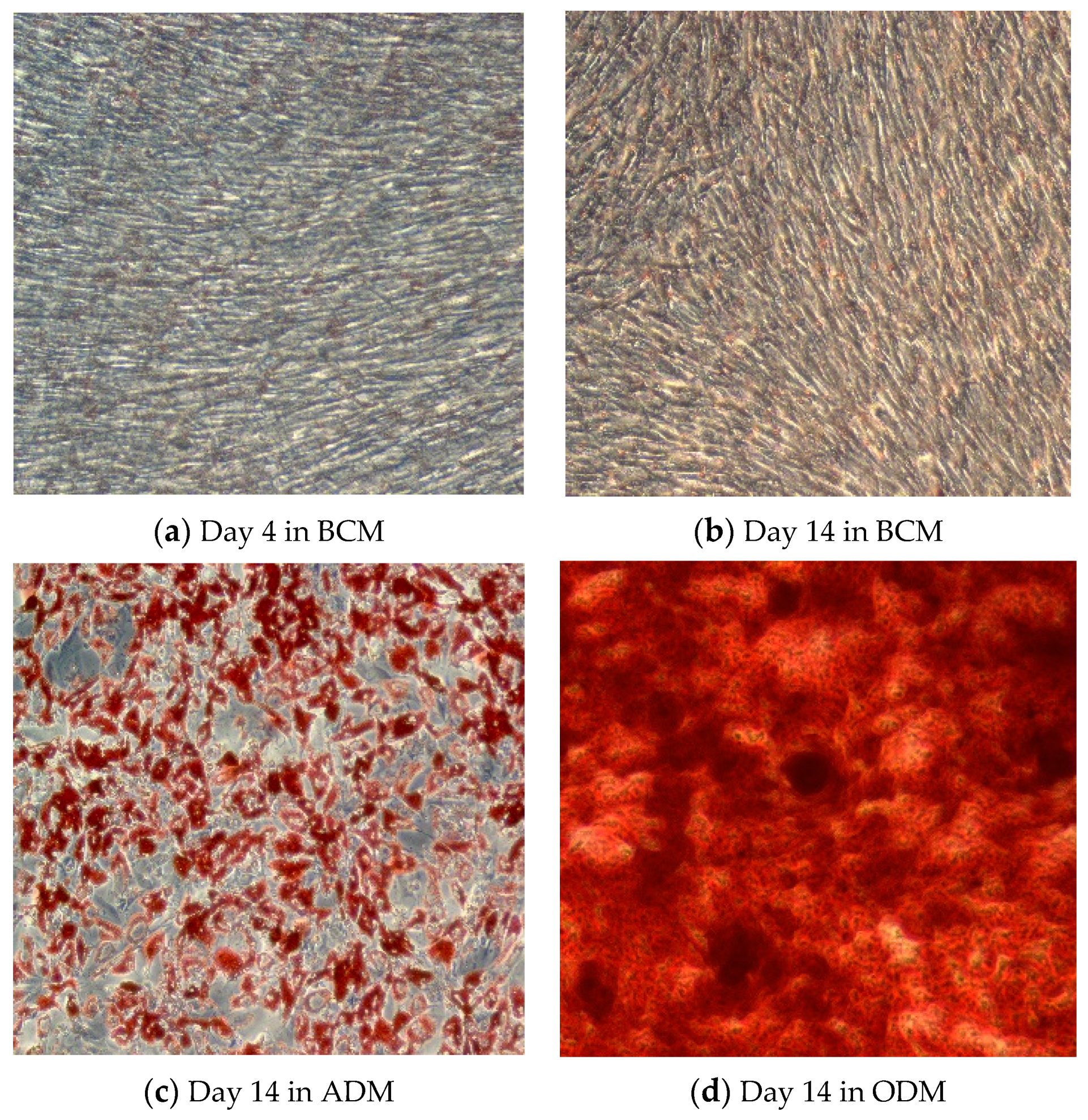


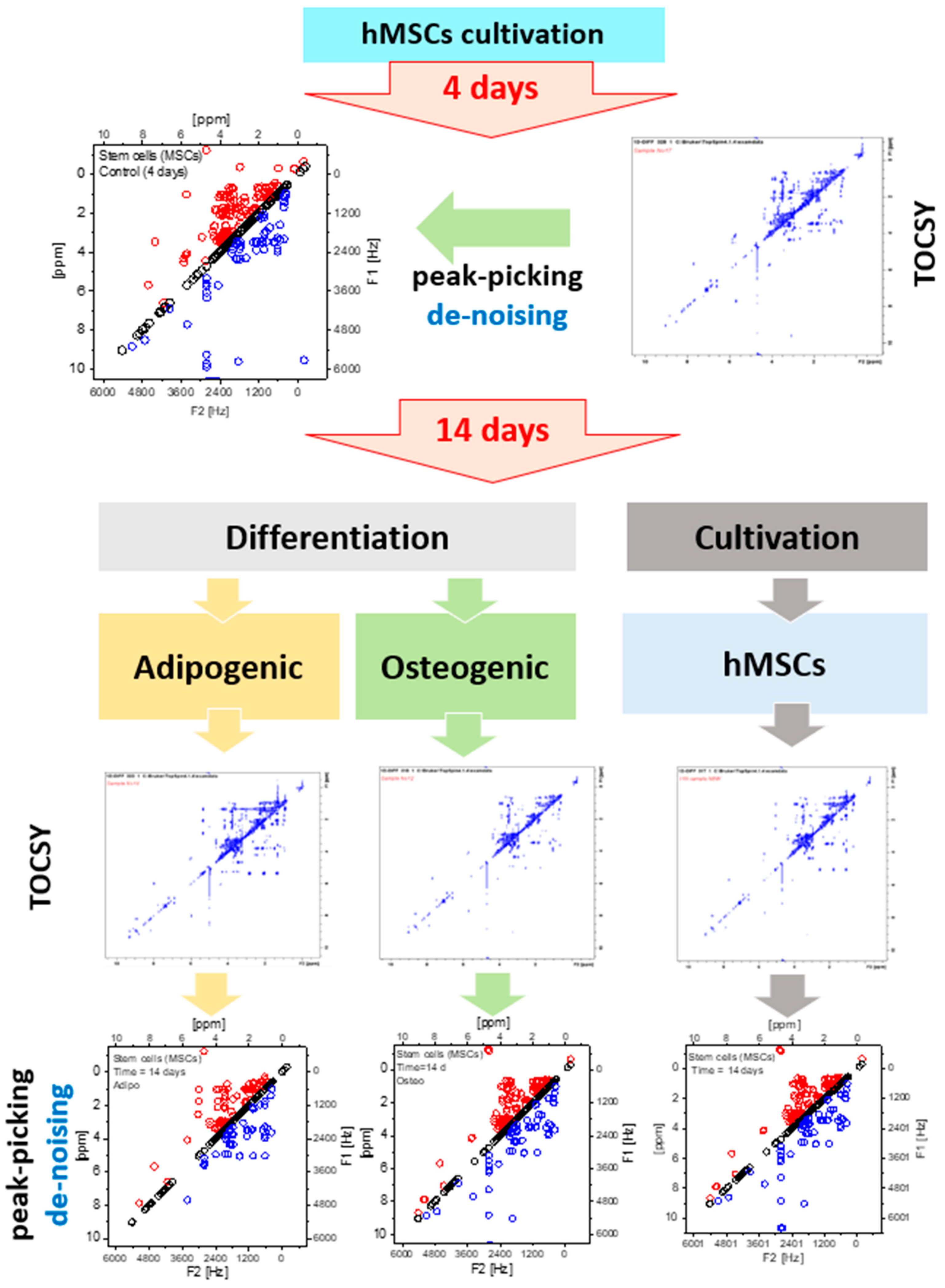
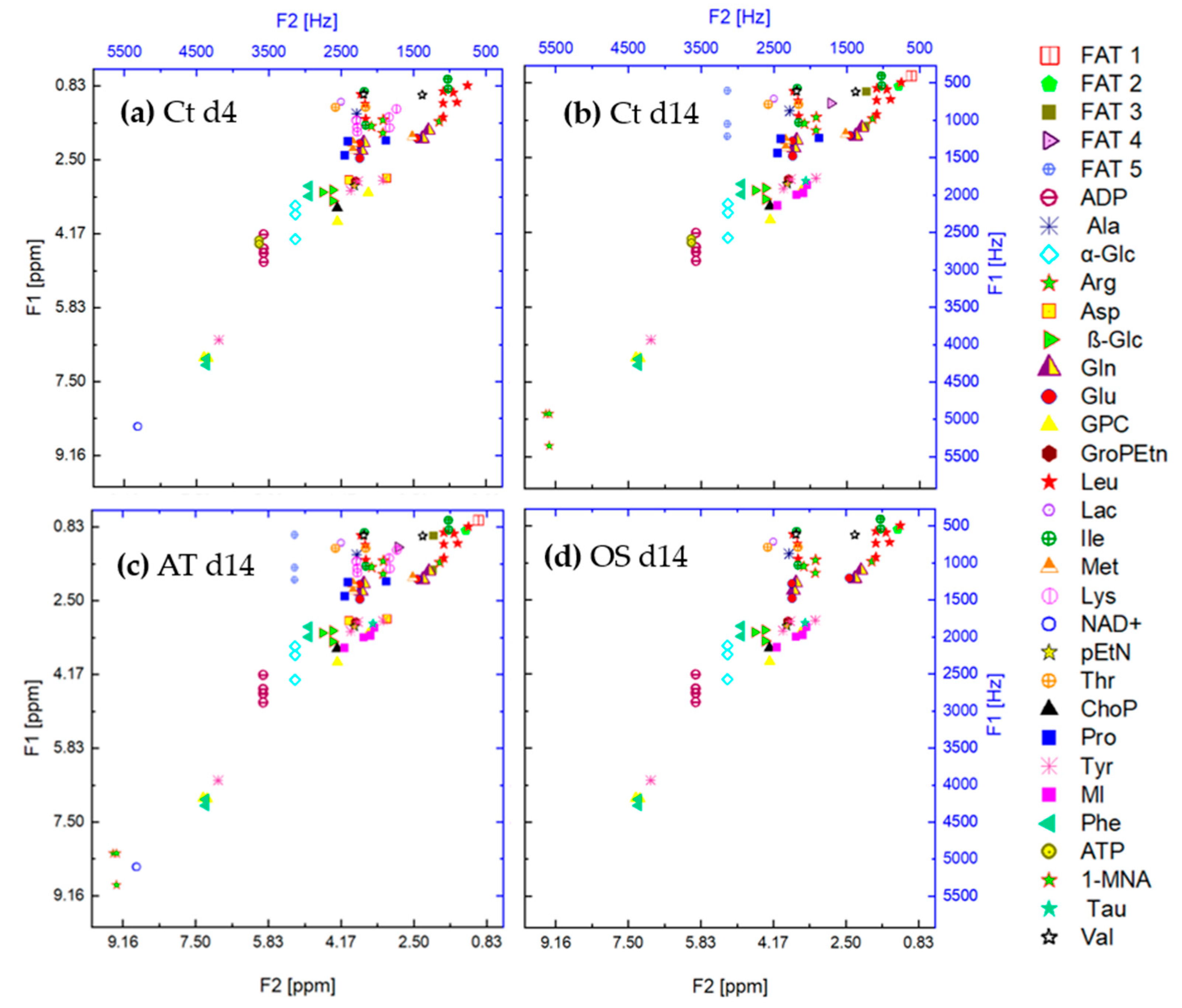
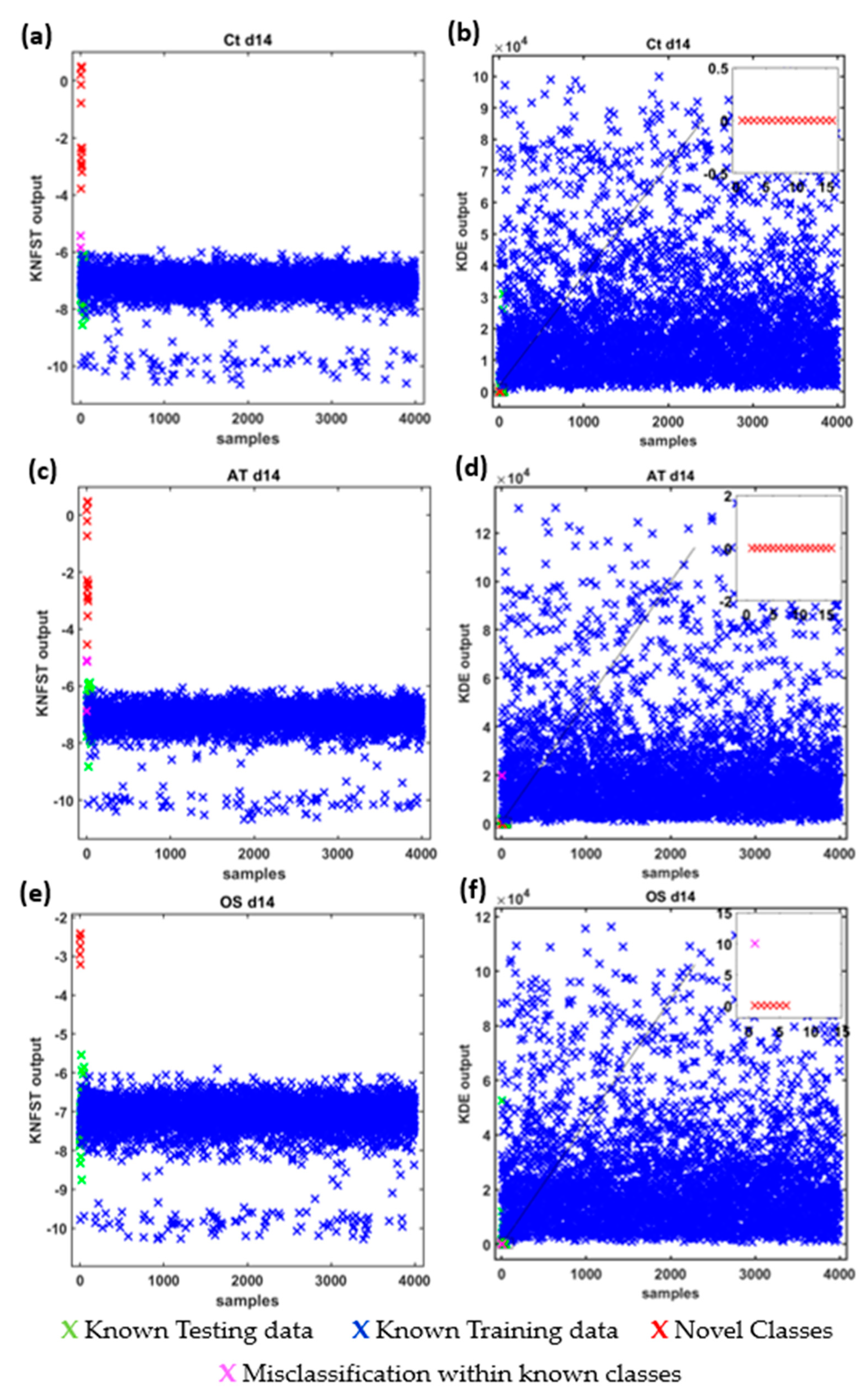

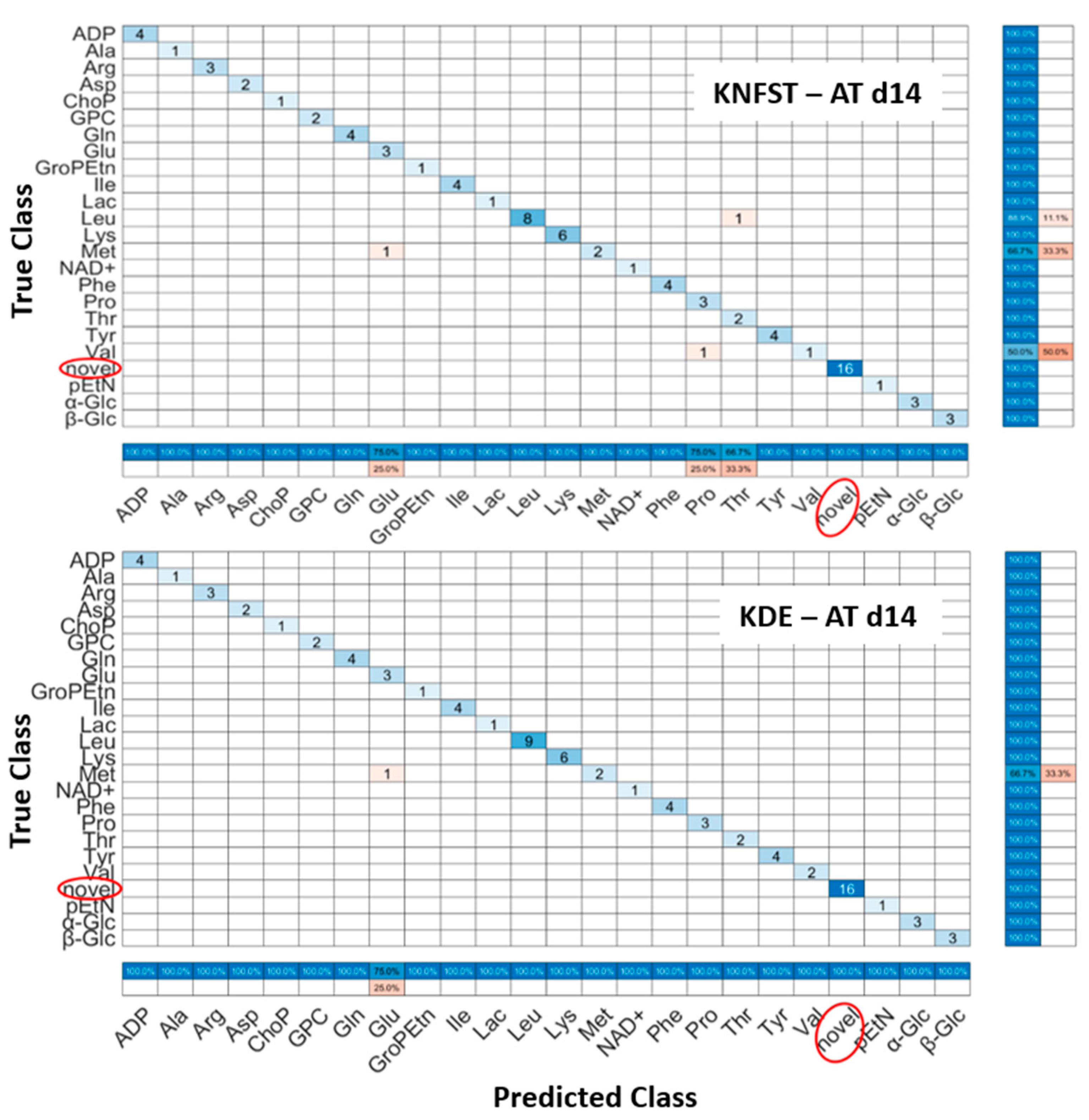

| Metabolite | Ct d4 | Ct d14 | AT d14 | OS d14 | Standard | |||||
|---|---|---|---|---|---|---|---|---|---|---|
| F2 | F1 | F2 | F1 | F2 | F1 | F2 | F1 | F2 | F1 | |
| Leu | 752 | 494 | 762 | 484 | 762 | 489 | 772 | 494 | 720 | 540 |
| Leu | 950 | 590 | 930 | 584 | 930 | 589 | 934 | 560 | 900 | 600 |
| Leu | 900 | 720 | 914 | 720 | 913 | 750 | 910 | 760 | 900 | 720 |
| Leu | 1040 | 610 | 1073 | 631 | 1060 | 638 | 1046 | 608 | 1080 | 600 |
| Leu | 1040 | 695 | 1073 | 705 | 1060 | 709 | 1046 | 749 | 1080 | 720 |
| Leu | 1040 | 893 | 1073 | 923 | 1060 | 912 | 1046 | 922 | 1080 | 900 |
| Leu | 2229 | 611 | 2210 | 608 | 2212 | 610 | 2198 | 620 | 2220 | 600 |
| Leu | 2170 | 737 | 2171 | 750 | 2171 | 752 | 2163 | 749 | 2220 | 720 |
| Leu | 2163 | 943 | 2168 | 943 | 2157 | 908 | 2175 | 921 | 2220 | 900 |
| Ile | 1020 | 540 | 1020 | 540 | 1020 | 540 | 1020 | 540 | 1020 | 540 |
| Ile | 1023 | 408 | 1009 | 403 | 1047 | 417 | 1045 | 417 | 1020 | 600 |
| Ile | 2180 | 570 | 2170 | 580 | 2178 | 578 | 2220 | 540 | 2220 | 540 |
| Ile | 2160 | 1032 | 2165 | 1042 | 2195 | 1052 | 2210 | 1003 | 2220 | 1020 |
| Tyr | 1920 | 1778 | 1920 | 1787 | 1920 | 1782 | 1920 | 1790 | 1920 | 1830 |
| Tyr | 2396 | 1788 | 2253 | 1784 | 2355 | 1786 | 2358 | 1780 | 2340 | 1830 |
| Tyr | 2304 | 1877 | 2253 | 1848 | 2356 | 1836 | 2356 | 1848 | 2362 | 1920 |
| Tyr | 4073 | 4067 | 4090 | 3946 | 4094 | 3961 | 4095 | 3952 | 4316 | 4139 |
| Phe | 2340 | 1853 | 2354 | 1906 | 2261 | 1778 | 2360 | 1848 | 2390 | 1868 |
| Phe | 2340 | 1934 | 2254 | 1960 | 2254 | 1926 | 2260 | 1913 | 2390 | 1970 |
| Phe | 4362 | 4193 | 4362 | 4193 | 4368 | 4193 | 4370 | 4197 | 4453 | 4422 |
| Phe | 4362 | 4273 | 4362 | 4275 | 4368 | 4273 | 4370 | 4286 | 4453 | 4394 |
| Glu | 1373 | 1102 | 1354 | 1106 | 1354 | 1106 | 1349 | 1106 | 1470 | 1260 |
| Glu | 2337 | 1043 | 2337 | 1057 | 2344 | 1048 | 2333 | 1062 | 2258 | 1278 |
| Glu | 2341 | 1278 | 2344 | 1269 | 2341 | 1288 | 2333 | 1278 | 2258 | 1468 |
| Gln | 1295 | 1100 | 1281 | 1100 | 1284 | 1071 | 1288 | 1100 | 1260 | 1200 |
| Gln | 1378 | 1220 | 1384 | 1200 | 1389 | 1210 | 1370 | 1230 | 1380 | 1200 |
| Gln | 2190 | 1269 | 2186 | 1288 | 2191 | 1288 | 2194 | 1288 | 2220 | 1200 |
| Gln | 2225 | 1370 | 2227 | 1367 | 2210 | 1380 | 2208 | 1369 | 2220 | 1380 |
| Lys | 1740 | 809 | NP | NP | 1736 | 783 | NP | NP | 1800 | 840 |
| Lys | 1844 | 893 | NP | NP | 1836 | 898 | NP | NP | 1800 | 900 |
| Lys | 1836 | 1062 | NP | NP | 1836 | 1058 | NP | NP | 1806 | 1032 |
| Lys | 2295 | 962 | NP | NP | 2290 | 962 | NP | NP | 2220 | 900 |
| Lys | 2282 | 1057 | NP | NP | 2278 | 1044 | NP | NP | 2250 | 1032 |
| Lys | 2282 | 1118 | NP | NP | 2286 | 1119 | NP | NP | 2250 | 1137 |
| FAT 1 | NP | NP | 616 | 405 | 600 | 420 | NP | NP | 600 | 420 |
| FAT 2 | NP | NP | 789 | 545 | 789 | 531 | 789 | 545 | 785 | 535 |
| FAT 3 | NP | NP | 1230 | 614 | 1245 | 620 | NP | NP | 1260 | 600 |
| FAT 3 | NP | NP | 1240 | 1080 | 1260 | 1080 | NP | NP | 1260 | 1050 |
| FAT 4 | NP | NP | 1715 | 772 | 1705 | 778 | NP | NP | 1792 | 766 |
| FAT 5 | NP | NP | 3139 | 607 | 3150 | 607 | NP | NP | 3180 | 540 |
| FAT 5 | NP | NP | 3138 | 1052 | 3150 | 1052 | NP | NP | 3180 | 1080 |
| FAT 5 | NP | NP | 3140 | 1217 | 3150 | 1219 | NP | NP | 3180 | 1260 |
| Lac | 2499 | 715 | 2494 | 709 | 2494 | 715 | 2494 | 720 | 2463 | 790 |
| Thr | 2160 | 789 | 2160 | 790 | 2160 | 720 | 2160 | 720 | 2160 | 780 |
| Thr | 2578 | 789 | 2537 | 790 | 2582 | 720 | 2573 | 720 | 2580 | 780 |
| Pro | 1879 | 1238 | 1869 | 1230 | 1873 | 1238 | NP | NP | 1980 | 1200 |
| Pro | 2408 | 1246 | 2408 | 1234 | 2408 | 1238 | NP | NP | 2472 | 1213 |
| Pro | 2408 | 1438 | 2435 | 1448 | 2405 | 1439 | NP | NP | 2472 | 1402 |
| Ala | 2270 | 723 | 2295 | 696 | 2295 | 705 | 2291 | 701 | 2256 | 876 |
| Val | 1350 | 632 | 1383 | 619 | 1394 | 619 | 1383 | 619 | 1380 | 617 |
| Val | 1875 | 1237 | 1890 | 1259 | 1880 | 1244 | 1870 | 1240 | 2160 | 617 |
| Met | 1518 | 1187 | 1523 | 1197 | 1518 | 1177 | NP | NP | 1560 | 1260 |
| Met | 2338 | 1270 | 2342 | 1274 | 2351 | 1277 | NP | NP | 2340 | 1260 |
| Met | 2338 | 1370 | 2342 | 1367 | 2351 | 1380 | NP | NP | 2340 | 1320 |
| pEtN | 2317 | 1852 | 2305 | 1848 | 2331 | 1865 | 2307 | 1849 | 2430 | 1950 |
| GroPEtn | 2300 | 1791 | 2291 | 1781 | 2293 | 1791 | 2292 | 1791 | 2300 | 1791 |
| ChoP | 2454 | 1950 | 2455 | 1953 | 2458 | 1954 | 2454 | 1947 | 2572 | 2187 |
| GPC | 2127 | 1943 | 2121 | 1943 | 2124 | 1939 | 2123 | 1939 | 2160 | 1980 |
| GPC | 2552 | 2333 | 2535 | 2338 | 2544 | 2359 | 2533 | 2348 | 2580 | 2340 |
| Arg | 1144 | 1000 | 1140 | 975 | 1143 | 984 | 1146 | 980 | 1120 | 920 |
| Arg | 1910 | 960 | 1920 | 960 | 1944 | 988 | 1928 | 988 | 1920 | 960 |
| Arg | 1974 | 1134 | 1978 | 1134 | 1986 | 1115 | 1969 | 1130 | 1920 | 1140 |
| MI | NP | NP | 2039 | 1880 | 2044 | 1869 | 2036 | 1869 | 2040 | 1800 |
| MI | NP | NP | 2088 | 1882 | 2093 | 1872 | 2087 | 1866 | 2112 | 1959 |
| MI | NP | NP | 2154 | 1970 | 2159 | 1977 | 2152 | 1972 | 2167 | 1959 |
| MI | NP | NP | 2460 | 2156 | 2452 | 2140 | 2452 | 2149 | 2423 | 2113 |
| Asp | 2390 | 1574 | NP | NP | 2398 | 1578 | NP | NP | 2400 | 1800 |
| Asp | 1870 | 1750 | NP | NP | 1876 | 1768 | NP | NP | 1800 | 1740 |
| Tau | NP | NP | 2064 | 1809 | 2065 | 1812 | 2063 | 1812 | 2040 | 1980 |
| α-Glc | 3135 | 2119 | 3125 | 2139 | 3137 | 2132 | 3140 | 2112 | 3130 | 2112 |
| α-Glc | 3135 | 2238 | 3125 | 2254 | 3137 | 2263 | 3140 | 2280 | 3130 | 2224 |
| α-Glc | 3135 | 2573 | 3125 | 2558 | 3132 | 2562 | 3140 | 2565 | 3130 | 2568 |
| β-Glc | 2760 | 1937 | 2774 | 1928 | 2765 | 1931 | 2759 | 1936 | 2778 | 1938 |
| β-Glc | 2717 | 2055 | 2714 | 2065 | 2717 | 2063 | 2717 | 2068 | 2778 | 2084 |
| β-Glc | 2717 | 2008 | 2714 | 2000 | 2712 | 2002 | 2714 | 2089 | 2778 | 2081 |
| ATP | 3620 | 2587 | 3640 | 2581 | NP | NP | NP | NP | 3620 | 2587 |
| ATP | 3620 | 2680 | 3640 | 2628 | NP | NP | NP | NP | 3620 | 2680 |
| ADP | 3569 | 2496 | 3566 | 2503 | 3566 | 2501 | 3570 | 2498 | 3569 | 2496 |
| ADP | 3569 | 2700 | 3566 | 2706 | 3569 | 2708 | 3569 | 2690 | 3569 | 2700 |
| ADP | 3569 | 2762 | 3566 | 2759 | 3569 | 2769 | 3569 | 2765 | 3569 | 2760 |
| ADP | 3569 | 2882 | 3566 | 2885 | 3569 | 2870 | 3569 | 2868 | 3569 | 2880 |
| NAD+ | 5310 | 5110 | NP | NP | 5302 | 5106 | NP | NP | 5200 | 5110 |
| 1-MNA | NP | NP | 5218 | 4718 | 5218 | 4725 | NP | NP | 5341 | 4921 |
| 1-MNA | NP | NP | 5412 | 4718 | 5412 | 4725 | NP | NP | 5581 | 4921 |
| 1-MNA | NP | NP | 5520 | 5328 | 5512 | 5321 | NP | NP | 5581 | 5341 |
| Ct d14 | AT d14 | OS d14 | ||||
|---|---|---|---|---|---|---|
| KNFST | KDE | KNFST | KDE | KNFST | KDE | |
| False negative rate | 0% | 0% | 0% | 0% | 0% | 0% |
| False positive rate | 0% | 0% | 0% | 0% | 0% | 0% |
| Total error | 2.6% | 0% | 3.6% | 1.2% | 0% | 1.7% |
Disclaimer/Publisher’s Note: The statements, opinions and data contained in all publications are solely those of the individual author(s) and contributor(s) and not of MDPI and/or the editor(s). MDPI and/or the editor(s) disclaim responsibility for any injury to people or property resulting from any ideas, methods, instructions or products referred to in the content. |
© 2023 by the authors. Licensee MDPI, Basel, Switzerland. This article is an open access article distributed under the terms and conditions of the Creative Commons Attribution (CC BY) license (https://creativecommons.org/licenses/by/4.0/).
Share and Cite
Migdadi, L.; Sharar, N.; Jafar, H.; Telfah, A.; Hergenröder, R.; Wöhler, C. Machine Learning in Automated Monitoring of Metabolic Changes Accompanying the Differentiation of Adipose-Tissue-Derived Human Mesenchymal Stem Cells Employing 1H-1H TOCSY NMR. Metabolites 2023, 13, 352. https://doi.org/10.3390/metabo13030352
Migdadi L, Sharar N, Jafar H, Telfah A, Hergenröder R, Wöhler C. Machine Learning in Automated Monitoring of Metabolic Changes Accompanying the Differentiation of Adipose-Tissue-Derived Human Mesenchymal Stem Cells Employing 1H-1H TOCSY NMR. Metabolites. 2023; 13(3):352. https://doi.org/10.3390/metabo13030352
Chicago/Turabian StyleMigdadi, Lubaba, Nour Sharar, Hanan Jafar, Ahmad Telfah, Roland Hergenröder, and Christian Wöhler. 2023. "Machine Learning in Automated Monitoring of Metabolic Changes Accompanying the Differentiation of Adipose-Tissue-Derived Human Mesenchymal Stem Cells Employing 1H-1H TOCSY NMR" Metabolites 13, no. 3: 352. https://doi.org/10.3390/metabo13030352







